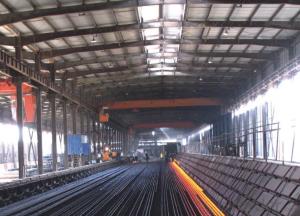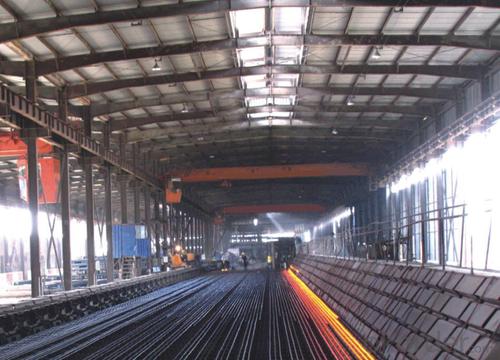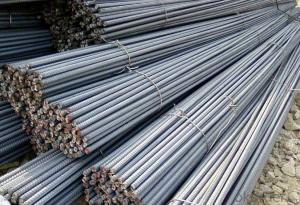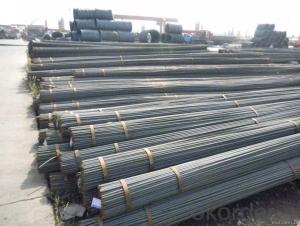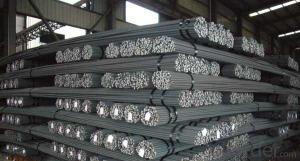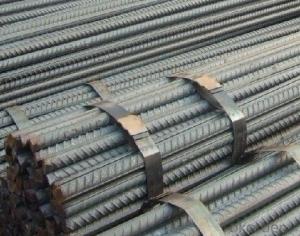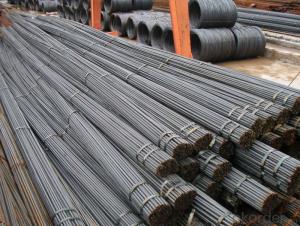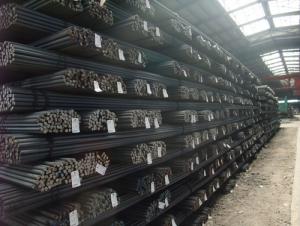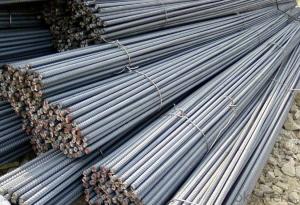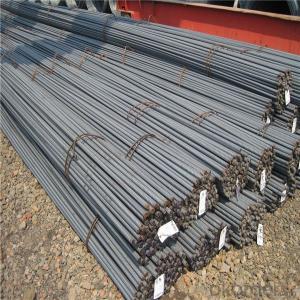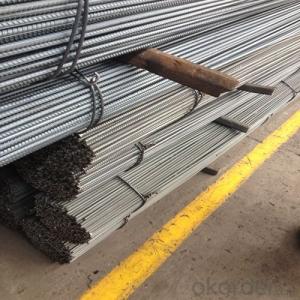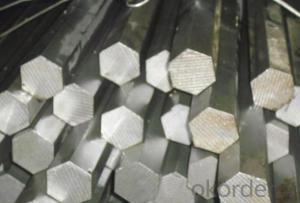Hot Rolled Deformed Steel Bar 12M Straight
- Loading Port:
- China main port
- Payment Terms:
- TT OR LC
- Min Order Qty:
- 100 m.t.
- Supply Capability:
- 100000 m.t./month
OKorder Service Pledge
OKorder Financial Service
You Might Also Like
Usage and Applications
Deformed bar is widely used in buildings, bridges, roads and other engineering construction. Big to highways, railways, bridges, culverts, tunnels, public facilities such as flood control, dam, small to housing construction, beam, column, wall and the foundation of the plate, deformed bar is an integral structure material. With the development of world economy and the vigorous development of infrastructure construction, real estate, the demand for deformed bar will be larger and larger.
Diameter(mm) | Section area (mm²) | Mass(kg/m) | Weight of 12m bar(kg) |
6 | 28.27 | 0.222 | 2.664 |
8 | 50.27 | 0.395 | 4.74 |
10 | 78.54 | 0.617 | 7.404 |
12 | 113.1 | 0.888 | 10.656 |
14 | 153.9 | 1.21 | 14.52 |
16 | 201.1 | 1.58 | 18.96 |
18 | 254.5 | 2.00 | 24 |
20 | 314.2 | 2.47 | 29.64 |
22 | 380.1 | 2.98 | 35.76 |
25 | 490.9 | 3.85 | 46.2 |
28 | 615.8 | 4.83 | 57.96 |
32 | 804.2 | 6.31 | 75.72 |
36 | 1018 | 7.99 | 98.88 |
40 | 1257 | 9.87 | 118.44 |
50 | 1964 | 15.42 | 185.04 |
Packaging & Delivery
Packaging Detail: products are packed in bundle and then shipped by container or bulk vessel, deformed bar is usually naked strapping delivery, when storing, please pay attention to moisture proof. The performance of rust will produce adverse effect.
Each bundle weight: 2-3MT, or as required
Payment term: TT or L/C
Delivery Detail: within 45 days after received advanced payment or LC.
Label: to be specified by customer, generally, each bundle has 1-2 labels
Trade terms: FOB, CFR, CIF
Cold Rolled Techniques
Yield Point: 545-565mpa
Deformed bar is widely used in buildings, bridges, roads and other engineering construction. Big to highways, railways, bridges, culverts, tunnels, public facilities such as flood control, dam, small to housing construction, beam, column, wall and the foundation of the plate, deformed bar is an integral structure material. With the development of world economy and the vigorous development of infrastructure construction, real estate, the demand for deformed bar will be larger and larger.
- Q: Can steel rebars be used in parking garage construction?
- Indeed, steel rebars find their application in the construction of parking garages. Reinforced concrete structures, such as parking garages, frequently employ steel rebars to augment their robustness and resilience. By distributing the load and bolstering the structural integrity of the concrete, rebars enable it to withstand substantial weights typically encountered in parking garages. The incorporation of steel rebars into parking garage construction is indispensable to ensure the enduring longevity and safety of the edifice.
- Q: Are steel rebars available in different shapes and profiles?
- Yes, steel rebars are available in various shapes and profiles to suit different construction needs.
- Q: Can steel rebars be used in structures with high resistance to vibration?
- Structures with high resistance to vibration can indeed make use of steel rebars. These rebars are frequently employed as reinforcements in concrete structures to enhance their durability and strength. The inclusion of steel rebars bolsters the structural integrity of buildings and infrastructure, rendering them more impervious to a range of forces, including vibrations. Steel rebars possess exceptional tensile strength and stiffness, enabling them to evenly distribute and absorb applied loads throughout the structure. This characteristic helps to minimize concentrated stress points that may trigger vibrations or structural failure. Moreover, steel rebars are effective in controlling crack widths and preventing crack propagation, which further fortifies the structure against vibrations. Furthermore, steel rebars can be tailored to meet specific requirements based on projected vibration levels. By utilizing rebars with suitable diameters, spacing, and anchorage details, structures can be engineered to withstand vibrations caused by various external factors, such as earthquakes, wind loads, or nearby machinery. It is of utmost importance to ensure proper design and detailing of steel rebars in structures with high resistance to vibration. The layout of reinforcements must be meticulously planned to account for anticipated forces and vibrations. Additionally, the rebars should be adequately anchored and connected to other structural components to maintain their efficacy in combatting vibrations. All in all, when designed and implemented correctly, steel rebars serve as a dependable and widely-used reinforcement material that significantly enhances the resistance of structures to vibrations.
- Q: What is the lifespan of steel rebars in a corrosive environment?
- The lifespan of steel rebars in a corrosive environment can vary depending on several factors such as the severity of the corrosive environment, the quality of the steel used, and the presence of protective measures like coatings or cathodic protection. However, on average, steel rebars can last anywhere from 20 to 50 years in a corrosive environment before significant corrosion damage occurs.
- Q: What is the role of steel rebars in the construction of power transmission towers?
- The role of steel rebars in the construction of power transmission towers is to provide structural reinforcement and strength to the concrete foundations and columns. Steel rebars act as a framework within the concrete, helping to distribute the load and withstand the forces exerted on the towers, including wind, seismic activity, and the weight of the transmission lines. They enhance the overall stability and durability of the towers, ensuring their ability to safely support and transmit electrical power.
- Q: Can steel rebars be used in structures with high resistance to moisture?
- Structures that require high resistance to moisture can incorporate steel rebars. Nonetheless, it is crucial to acknowledge that steel is prone to corrosion when exposed to moisture for extended periods. In order to mitigate this risk, preventive measures such as implementing adequate concrete coverage and waterproofing techniques are necessary. Furthermore, utilizing steel rebars with corrosion-resistant coatings or alloys, such as epoxy-coated or stainless steel rebars, can significantly augment moisture resistance. The longevity and durability of structures in high-moisture environments heavily rely on proper design, construction, and maintenance practices.
- Q: Can steel rebars be used in industrial flooring?
- Yes, steel rebars can be used in industrial flooring. Steel rebars are commonly used in concrete construction, including industrial flooring, due to their high tensile strength and durability. They are typically placed within the concrete to reinforce it and provide added strength to support heavy loads and resist cracking. The use of steel rebars in industrial flooring helps increase its load-bearing capacity and ensures the longevity and structural integrity of the floor. Additionally, steel rebars can be easily welded or connected to form a grid or mesh, which further enhances the strength and stability of the floor. Therefore, steel rebars are a suitable choice for industrial flooring applications.
- Q: What is the role of steel rebars in preventing concrete creep?
- The role of steel rebars in preventing concrete creep is crucial. Concrete creep refers to the gradual deformation or movement of concrete over time under sustained load. This phenomenon occurs due to the long-term stress on the concrete, causing it to slowly deform and creep. Steel rebars, which are reinforced steel bars, are used in concrete structures to counteract this creep behavior. They play a significant role in preventing concrete creep by providing tensile strength and reinforcing the structure. When concrete is subjected to a load, it experiences both compressive and tensile forces. While concrete is excellent at withstanding compressive forces, it is relatively weak in tension. This is where steel rebars come into play. By placing steel rebars within the concrete, the tensile strength of the structure is significantly enhanced. Steel has high tensile strength, making it ideal for bearing the tension experienced by the concrete. When the concrete begins to creep under a sustained load, the steel rebars resist the deformation and distribute the tensile forces throughout the structure. The presence of steel rebars helps to restrain the concrete from excessive deformation, reducing the potential for long-term creep. By reinforcing the concrete with steel rebars, the structure becomes more resistant to creep and maintains its stability and integrity over time. Moreover, steel rebars also enhance the overall durability and structural performance of the concrete. They improve the load-bearing capacity, prevent cracking, and enhance the resistance against external forces such as earthquakes or environmental factors. In conclusion, steel rebars play a vital role in preventing concrete creep by providing tensile strength and reinforcing the structure. They resist the deformation of the concrete under sustained load, ensuring its stability and long-term integrity. The use of steel rebars significantly enhances the durability and structural performance of concrete structures, making them more resistant to creep and other potential issues.
- Q: Can steel rebars be recycled after the demolition of a structure?
- Yes, steel rebars can be recycled after the demolition of a structure. Steel is a highly recyclable material and rebars are commonly collected and reused in the steel industry for the production of new steel products. Recycling steel rebars helps conserve natural resources and reduces the environmental impact of construction projects.
- Q: What are the different methods of protecting steel rebars against corrosion?
- There are multiple methods available for safeguarding steel rebars from corrosion, which can be broadly categorized into passive and active protection. Passive protection methods involve using barrier coatings or inhibitors to prevent corrosive agents from reaching the surface of the steel rebars. One commonly used technique is applying epoxy coatings, which create a physical barrier between the rebar and its surrounding environment. These coatings can be administered through spraying, brushing, or immersion, and offer excellent corrosion protection. Another passive protection method is utilizing zinc-based coatings like galvanization or zinc-rich paints. These coatings provide sacrificial protection, where the zinc layer corrodes first, thereby shielding the steel rebar from corrosive elements. Galvanization, a widely adopted technique, involves immersing the rebar in molten zinc to form a protective layer. In addition to barrier coatings, inhibitors can also be employed to protect steel rebars. Inhibitors work by reducing the corrosive activity of the surrounding environment. Common inhibitors include calcium nitrite, which forms a protective layer on the rebar's surface, and organic compounds such as amines and phosphates, which passivate the steel and decrease corrosion rates. Active protection methods involve using impressed current cathodic protection (ICCP) or galvanic anodes. ICCP entails applying a direct electrical current to the steel rebar, counteracting the corrosive forces. This technique necessitates the installation of anodes and a power supply system. On the other hand, galvanic anodes are sacrificial metals like aluminum or magnesium that are connected to the steel rebar. The anode corrodes instead of the rebar, offering protection. It is important to consider various factors, including the environment, exposure conditions, and project requirements, when selecting a protection method. Consulting corrosion experts or engineers is often recommended to determine the most suitable method for safeguarding steel rebars from corrosion in a specific situation.
Send your message to us
Hot Rolled Deformed Steel Bar 12M Straight
- Loading Port:
- China main port
- Payment Terms:
- TT OR LC
- Min Order Qty:
- 100 m.t.
- Supply Capability:
- 100000 m.t./month
OKorder Service Pledge
OKorder Financial Service
Similar products
Hot products
Hot Searches
Related keywords
